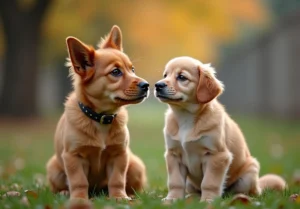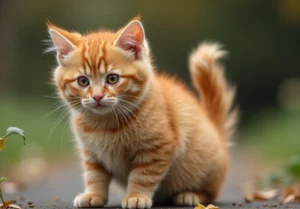Ever wondered why cats get fluffy tails? Let’s explore the fascinating reason behind this common feline phenomenon.
Have you ever noticed how cats’ tails can go from sleek to fluffy in an instant? The answer lies in a combination of biology and behavior.
Evolution of Fluffy Tails
Cats have been evolving for millions of years, adapting to their environments in various ways. The evolution of fluffy tails in cats is a fascinating process that has helped them survive and thrive in different habitats. One theory suggests that the fluffy tail trait developed as a way to regulate body temperature. In colder climates, a bushy tail can act as insulation, preserving heat and helping cats stay warm during harsh winters. This evolutionary advantage enabled fluffy-tailed species to expand their habitats to colder regions.
Another aspect of the evolution of fluffy tails is linked to predator-prey dynamics. Some researchers believe that a fluffy tail can make a cat appear larger and more intimidating to potential predators, deterring them from attack. This evolutionary defense mechanism has helped fluffy-tailed cats avoid becoming prey themselves, showcasing the adaptive value of this unique trait.
Communication Tool
Cats are known for their intricate communication skills, and their fluffy tails play a crucial role in this aspect. When a cat is feeling happy or content, its tail may stand upright with a slight curve at the tip, signaling friendliness and approachability. Conversely, a fluffy tail held low or tucked between the legs can indicate fear, stress, or aggression.
Additionally, cats often use their fluffy tails to communicate with other animals and even humans. A gently twitching tail can be a sign of curiosity or excitement, while a vigorously flicking tail may signal irritation or agitation. By observing a cat’s tail movements along with other body language cues, you can better understand their emotions and responses to the environment.
Bonus Tip:
– Pay attention to the position and movements of your cat’s tail to decipher their feelings and intentions accurately. Understanding this form of feline communication can strengthen your bond with your furry companion.
Explore the fascinating world of fluffy tails, delving into the evolutionary origins and communicative functions of this unique feature found in our feline friends.
Seasonal Changes
Cats are like mini fashionistas when it comes to their fluffy tails! Just like how we change our clothes depending on the weather, cats can also adapt their tail fluffiness depending on the season. In the colder months, you might notice your furry friend’s tail getting fluffier. This is their way of staying warm and cozy when the temperatures drop. On the flip side, as the weather warms up, their tails might appear less fluffy as they don’t need as much insulation. So, next time you see your cat rocking a super fluffy tail in the winter, just remember they’re staying stylish and warm at the same time!
Warmth and Insulation
Picture this: your cat is all curled up, and their fluffy tail is wrapped around them like a cozy blanket. That fluff isn’t just for show; it actually helps them regulate their body temperature and stay warm in chillier climates. The fluffy tail acts as a natural insulator, trapping heat close to their body to keep them snug as a bug in a rug. So, when your feline friend is snuggled up with their fluffy tail, they’re not just being cute – they’re also using it as their personal heating system. It’s like having a built-in blanket wherever they go!
Additional Unique Insight:
If your cat is feeling stressed or anxious, you might notice their tail fluffing up more than usual. This is because cats use their tails as a way to communicate their emotions, and a fluffier tail can signal unease or tension. So, if you see that fluffy tail in action, it might be a good time to give your kitty some extra love and attention to help them feel more at ease.
Emotional Indicator
Have you ever noticed how a cat’s fluffy tail can serve as a window into their emotions? When a cat is feeling threatened or scared, their tail will puff up as a defense mechanism. This fluffiness makes them appear larger and more intimidating to potential threats. So, next time you see a cat with a fluffy tail, remember that it could be a sign that they are feeling anxious or concerned.
Grooming and Maintenance
Keeping your cat’s fluffy tail in top condition is essential for their overall health and well-being. Regular grooming not only prevents matting and tangles but also helps distribute natural oils that keep their fur healthy and shiny. Make sure to use a cat-specific brush to gently remove any loose fur and help your feline friend maintain a pristine tail.
Tips for Grooming and Maintaining a Cat’s Fluffy Tail:
- Brush Regularly: Set aside some time each week to brush your cat’s tail, paying special attention to the fluffiest parts.
- Check for Mats: Inspect your cat’s tail for any mats or tangles that may need to be carefully removed.
- Trim as Needed: If your cat has a particularly long or bushy tail, consider trimming the fur to keep it more manageable.
- Provide a Balanced Diet: A healthy diet rich in essential nutrients will help maintain your cat’s overall coat health, including their fluffy tail.
Remember, a well-groomed and maintained fluffy tail not only looks good but also contributes to your cat’s overall happiness and comfort.
Genetic Factors
Have you ever wondered why some cats have fluffy tails while others don’t? Well, genetic factors play a significant role in determining the fluffiness of a cat’s tail. Just like how genes determine a cat’s color or pattern, they also influence the texture and length of their tail fur. Some breeds are naturally predisposed to have fluffier tails due to specific genetic traits passed down through generations.
For instance, Persian cats are known for their luxurious, thick fur, which extends to their tails as well. On the other hand, Siamese cats tend to have sleek, short coats, resulting in less fluffy tails. This variation in tail fluffiness among different breeds showcases the diversity that exists within the feline world. Whether your cat has a plush tail or a more streamlined one, appreciate their uniqueness and the role genetics play in shaping their appearance.
Fun Fact: Maine Coon Tails
When it comes to exceptionally fluffy tails, Maine Coon cats take the crown. These gentle giants are renowned for their impressively fluffy tails compared to other breeds. The secret behind the Maine Coon’s majestic tail lies in their adaptation to the harsh winters of Maine, where they originated from.
Maine Coons have long, bushy tails that serve as insulation against the cold weather, allowing them to survive and thrive in harsh conditions. This unique trait has been passed down through generations, making Maine Coon tails a hallmark of the breed. So, if you own a Maine Coon cat, cherish their extra fluffiness as a tribute to their ancestral roots.
- Tip: Regular grooming is essential to maintain the fluffiness of your cat’s tail, especially for breeds with longer fur. Brushing their tail gently can help prevent tangles and mats, ensuring it stays soft and lovely.
Alex, a passionate animal lover, has experience in training and understanding animal behavior. As a proud pet parent to two dogs and three cats, he founded AnimalReport.net to share insights from animal experts and expand his knowledge of the animal kingdom.




